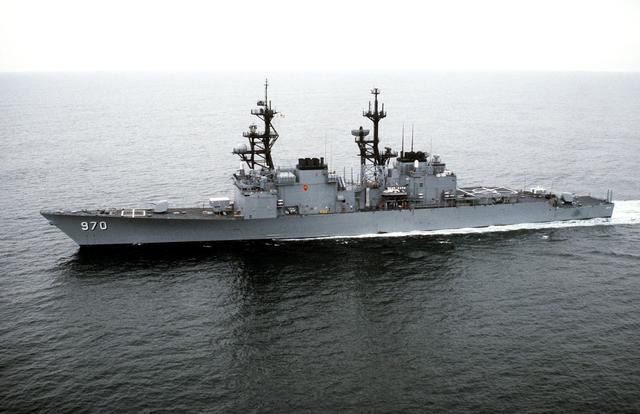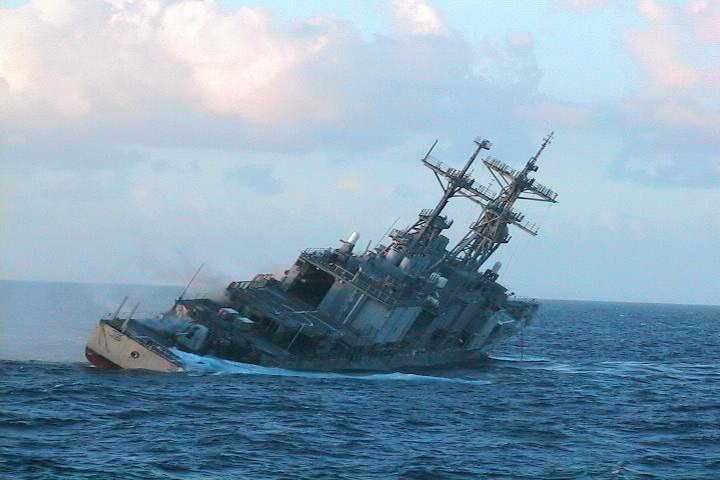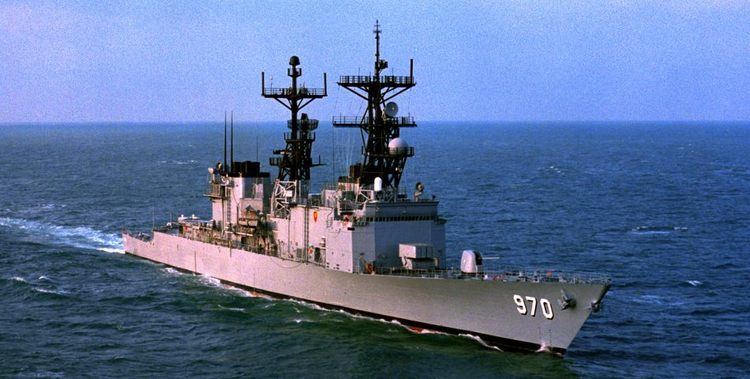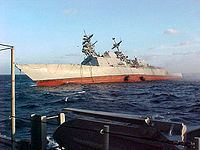Namesake Wayne Caron Laid down 1 July 1974 Commissioned 1 October 1977 Construction started 1 July 1974 Draft 8.84 m | Ordered 15 January 1971 Acquired 5 September 1977 Decommissioned 15 October 2001 Launched 24 June 1975 Beam 17 m | |
 | ||
Tribute to the can do uss caron dd970
USS Caron (DD-970) was a Spruance-class destroyer, named for Hospital Corpsman Third Class Wayne M. Caron (1946–1968), who was killed in action during the Vietnam War, and posthumously awarded the Medal of Honor.
Contents
- Tribute to the can do uss caron dd970
- Uss caron getting rammed by the russians in the black sea feb 1988
- Service history
- Incidents in Soviet waters
- Ships crest
- References

Uss caron getting rammed by the russians in the black sea feb 1988
Service history

Caron was laid down by the Ingalls Shipbuilding Division of Litton Industries at Pascagoula, Mississippi on 1 July 1974. She was commissioned on 1 October 1977.
In August 1979 Soviet planes staged a mock missile attack against the Caron in the Black Sea. In October 1983 the Caron participated in Operation Urgent Fury in the vicinity of Grenada. From November 1983 to March 1984 she was part of the Multi National Peacekeeping Force in Beirut, Lebanon.

On 10 March 1986, Caron departed Norfolk, Virginia with the America carrier battle group, for a Mediterranean deployment. During this deployment, the Action in the Gulf of Sidra took place during a freedom of navigation exercise in the Gulf of Sidra. This action saw U.S. Navy fighter aircraft shoot two Libyan Air Force fighters down. On 23 March 1986 – Operating with Ticonderoga and Scott, Caron moved south of the Libya–claimed "Line of Death". Libya reacted with two days of low intensity conflict in which Caron did not fire any weapons.

On 12 February 1988 Caron was lightly rammed by Soviet Mirka II class light frigate (FFL 824) in the Black Sea (see Incidents in Soviet waters below).
On 15 February 1990 Caron completed a regular overhaul.
Caron was deployed to the Middle East after the Iraqi invasion of Kuwait in 1990, and from 14 January 1991 she participated in Operation Desert Storm.
On 14 October 1993 she began participation in United Nations-mandated U.S.-executed sanctions enforcement operations against Haiti. She was one of six US Navy ships prepositioned off Haiti as a result of an order by President Bill Clinton. Clinton's order allowed the ships to be in position to enforce United Nations sanctions fully on the date at which they went into effect.
In April 1995 Caron took part in NATO mine countermeasures exercise off Denmark.
From January to July 1996 she deployed to Persian Gulf upholding United Nations sanctions against Iraq and aiding in Operation Southern Watch.
From February to 3 July 1998 she deployed to the Mediterranean and Persian Gulf, operating with John C. Stennis and Carrier Group Seven. During this deployment, Helicopter Antisubmarine Squadron Light 46 (HSL-46) Detachment 3 maintained 2 SH-60B Seahawk onboard Caron. One of the first exercises during this deployment was Exercise Shark Hunt 98 in April 1998 off the coast of Spain.
From January to 4 June 1999 she completed a regular overhaul at Newport News Shipbuilding. This overhaul included modifications to accommodate female crew. In June to December 2000 she deployed to the Mediterranean Sea and Persian Gulf, operating with the George Washington battle group.
On 15 October 2001 the ship was decommissioned.
On 4 December 2002 Caron was sunk prematurely off the coast of Puerto Rico as a result of explosives tests.
Incidents in Soviet waters
In March 1986, Caron's presence in Soviet territorial waters prompted a Soviet diplomatic protest.
In February 1988, Caron operating with Yorktown, entered Soviet 12 miles (19 km) territorial waters limit in the Black Sea off the Crimean Peninsula. Under international law, this act could be permissible if the ship was progressing from one point in international waters to another point in international waters via the shortest course possible, but according to the Soviet Union, it was the right of the USSR to authorize or prohibit travel in selected areas within the 12 mile limit. The United States however did not recognize the Soviet's claim in this case. To prevent it from becoming accepted precedent, the US Navy claimed that it had sailed warships through such areas at regular intervals in the past in accordance with established international law.
In response, the Soviets deployed a frigate "Bezzavetnyy" (rus.: "Беззаветный", Burevestnik M-class frigate) and a SKR-6 (rus.: CКР-6) Mirka II class light frigate as well as many other Soviet Navy, Coast Guard, KGB and "civilian" ships to intercept the U.S. ships. Soviet aircraft continuously buzzed the Caron and Yorktown as smaller vessels weaved to and fro in front of the American ships. Several times, Soviet vessels and aircraft obtained radar "lock" on the Caron and Yorktown. Both American ships maintained a constant course and speed throughout the incident. Eventually, the Soviets lightly rammed both ships. No significant damage resulted to any of the ships involved.
Ship's crest
The design of the shield and crest of the coat of arms is based on service of Wayne Maurice Caron, Hospital Corpsman Third Class, United States Navy, who heroically sacrificed his life on 28 July 1968 while aiding wounded Marines on the field of fire in Vietnam. The Medal of Honor was awarded him posthumously. Caron is named in his honor.
The light blue center section and the white five-pointed star allude to the Medal of Honor ribbon; the star is also inverted in reference to the silhouette of the Medal of Honor pendant. The one light blue and the two Navy blue sections refer to the courage, steadfast determination and selfless dedication of Petty Officer Caron in performance of duty while serving as Platoon Corpsman with Company K, Third Battalion, Seventh Marines, 1st Marine Division. The sweep of his unit through an open rice field in Quảng Nam Province is indicated by the scarlet base and the embattled gold chevron. Navy blue and gold and scarlet and gold are the colors of the Navy and Marine Corps.
The Navy-blue caduceus is the insignia worn on white uniforms by Hospital Corpsmen, United States Navy. This insignia and the crossed bayonets (in the colors of the Marine Corps) allude to the medical services customarily provided to the Marine Corps by the Navy. In particular, the caduceus and bayonets symbolize the combat operation in which Petty Officer Caron, though grievously wounded, was killed while giving medical assistance to his wounded comrades.
